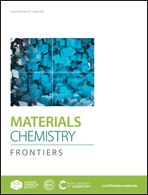A supramolecular strategy for gated photochromism in aqueous solution and solid state†
Abstract
Compared to traditional photochromism systems, gated photochromism systems are less vulnerable to external interference factors and hence more favorable for the construction of sensors and switches. In the current work, we developed a supramolecular host–guest strategy for gated photochromism in aqueous solution and the solid state. The water-soluble diarylethene derivative Go was synthesized and the reversible photoreaction was achieved by alternating irradiation with UV and visible light. Driven by the hydrophobic effect and ion–dipole interactions, Go bound a cucurbit[10]uril (CB[10]) macrocyclic host to form the 1 : 1 host–guest complex CB[10]·Go, which was photo-inactive both in aqueous solution and the solid state. In the crystal structure of CB[10]⋅GO, the distance between the two active carbon atoms of Go was found to be far greater than the allowed distance for the cyclization reaction. The conformational variation induced by the host–guest interaction was determined to be responsible for the photochromism “off” state. Besides, the “off” state of CB[10]·Go in aqueous solution could be reactivated by carrying out competitive binding, and the photoactivity of CB[10]·Go in the solid state could be turned on by subjecting it to mechanical grinding. Our study has provided a new strategy based on the use of diarylethene for the construction of a gated photochromism system, especially in the solid state, and has further expanded the application of host–guest interactions in photochromism systems.



 Please wait while we load your content...
Please wait while we load your content...